|
|
|

About Smallbore Rifle Competition:
Many individuals become interested in smallbore rifle competition, however, unless they start off with the proper information, (that's why I made these pages) they find it difficult and sometimes intimidating to begin. For most shooters the cost of equipment is generally a stumbling block. With a new Anschütz or Walther rifle running upwards of \$2000 just for the basic rifle, many people shy away from competition. Many feel that unless they have the best of everything they cannot compete. This is simply not true. I can tell you from my own experience that you can start with the basics. A minimum investment of a .22 caliber rifle (new or used), a simple spotting scope with stand, a sling, glove and shooting coat, and most important, eye and ear protection, you can begin shooting in competition for under \$1000. I started for less than that!
My first competition I used a piece of carpet for a mat, one of my winter gloves for a shooting glove, a pair on binoculars for a spotting scope, a heavy sweatshirt for a shooting jacket. My first rifle was a used entry level Lakefield bolt action target rifle which I paid a little over \$200 for. It came with a nice set of adjustable peep sights. The only new stuff I had to buy was a hand stop and a sling. The trigger was horrid and the carpet was smelly (I got it from someone's trash), but I was shooting in a competition, all said and done for about \$275 and that included a bunch of Eley 22 practice ammo. Considering all the substituted equipment I did fairly well and I had a great time shooting. Since then I have moved up to an intermediate grade rifle, a Weinrauch 660. It's not the best rifle but it does the job, and at this point it matches my shooting abilities. Soon I will be ready to move up to a real smallbore rifle such as an Anschütz or a Walther. If you stop back here in a while you will probably read about my buying escapades.
Equipment:
All of what we do in Smallbore Rifle is laid out in the NRA Smallbore Rules book. If you plan on shooting smallbore rifle, I would suggest that this be the first item you buy. A copy can be ordered from the NRA for only a few dollars. The book is divided up into sections that allow you to easily find specific rules and details about shooting smallbore rifle competition.
Section 3 of the NRA Smallbore Rifle Rule Book defines authorized equipment and ammunition. This section is not meant to restrict equipment but to define limitations. It lays out the rules for what is allowed while competing. Most of the language is easy to understand although in the beginning I found there were terms that I did not understand. Thankfully there are many experienced smallbore shooters in the Roslyn Rifle and Revolver club who are willing to explain any and all aspects of the game. In my opinion shooting with experienced folks is invaluable. This is one of the reasons that the Roslyn Rifle and Revolver clubs Friday night shoots are open to anyone who is interested.
Some Equipment you will need to get started:
Rifle - (light rifle or match rifle) Bolt-action single shot 22lr. is what most smallbore shooters use. Some names you might see on the line are Winchester, Anschütz, Walther, Kimber, and a few even shoot custom made rifles. Whichever rifle you select, be sure it will be suited for the rules of the particular type of shooting you wish to do. A used rifle for a beginner is not a bad idea if the dealer can certify the condition of the rifle.
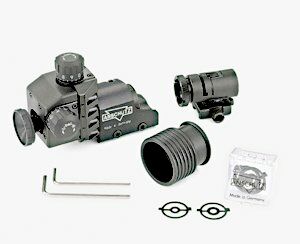
Rifle Sights - After checking the rule book, the purchase of good quality sights for whatever type of shooting your planning on is a sound investment. I can’t over emphasize the need for quality sights. Both Iron sights, some times known as peep sights, and scopes come in varied quality. For the most part you get what you pay for. Ask a few shooters to look through their sights and scopes to get a feel for what you might like to use. Throughout the year we shoot smallbore rifle matches with both scopes and iron sights, but as any coaches will tell you it is always best to start with and learn the game with iron sights. The picture to the left is of a high quality Anschütz sights set complete with front and rear appatures
Spotting Scope/Stand - It is the most important piece of equipment after the rifle and rifle sights. It allows you to check your target from a distance. When using iron sights to shoot, having a spotting scope is an absolute must. With your target some 50 feet or 50 yards away it is impossible to see your shot hole with the naked eye. Spotting scopes are precision optical instruments (again, you get what you pay for). Scope stands should be sturdy and be able to support the scope in all three positions. |
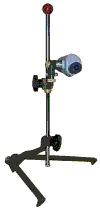 |
Gun Case - Used to protect your rifle as you travel to and from the range. After you have invested a considerable amount of money in a good target rifle, you certainly want to protect it from bumping around. Also note that cases are necessary in some areas to comply with local laws.
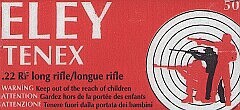 |
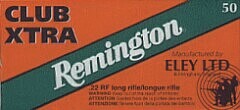 |
Ammunition - Generally, standard velocity ammunition will shoot more accurately than will high velocity. If you wish to become more competitive, tournament quality ammunition best suited to your particular gun will give the best results. It is important for you to try a variety of ammo in your rifle. Ask any experienced smallbore shooter which ammo to use and they will tell you, it depends on which ammo your rifle likes. It seems that in the game of smallbore the rifles can be very finicky. Even from lot to lot ammo can vary in the way it performs. When you are starting out, do not proceed with the mind set that this is just practice, I don’t need good ammo. When you are learning technique you won’t know if it is you making the mistake or the ammo. A very common mistake some people make is to buy the cheap high velocity ammo that is sold in bulk boxes for a few dollars per 500 rounds. This ammo is fine for shooting at the proverbial tin can or plinking, but will be a huge disappointment when you are striving for repeatability. The Ammo manufacturers such as Eley, Federal, RWS, Lapua, Wolf all make practice grades of match ammo that can be purchased for 3.00 – 5.00 per box. You will progress much faster using quality ammo that has repeatability. Once you have learned the techniques of the game you will want higher grades of ammo to match your abilities. My personal choice for indoor shooting happens to be the Eley Club orange box ammo. I use this ammo for practice and indoor matches. It is the best cross between price and performance, and my Weinrauch 660 happen to really like it.
Shooting mat – Although not a required item, it sure beats the heck out laying on the ground or the cold cement. When I first started out I used a piece of old carpet that I rolled up and took with me to the range. Mats come in all shapes and styles, when shopping for one, make sure you ask if it is left handed or right handed. The mat will have some non slip material for your elbow and it will do you no good if it’s on the wrong side when in the prone position. Some of the new ones, such as the one pictured here, have the non slip material on both sides.
Shooting coat – Shooting coats can be very expensive. Try and find a used one to start out. The purpose of the coat is to add some stiffness to your body while in the various positions. It can also help isolate your body movements from the rifle, such as your breathing and your pulse. I found, as others have, that at times my pulse is so pronounced that I needed a little extra isolation. I wear a light sweatshirt under my shooting coat to add some further padding. When you look for a shooting coat, remember it is suppose to be stiff, and it is suppose to be a little tight. Keep in mind, you can wear a sweater or an extra shirt under the jacket if you find it is just a little loose.
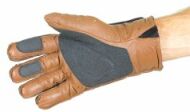
Glove – Like the coat, the shooting glove adds some isolation from your movements, and it also adds a little comfort. When shopping for a shooting glove look for gloves that have non-slip material on the palm and inside fingers and on the top of the fingers. Again this is something that can be bought used. Remember, a right handed shooter needs a left glove and the left handed shooter needs a right glove. Shooting gloves are sold individually not in pairs.
Sling – The Sling is your support system in the Prone and kneeling position. There are many different styles available. And they range in price from 20.00 – 100.00 they all perform the same function, the more expensive ones are more adjustable. When shopping for a sling make sure that the sling will work with the hand stop on your rifle. Like I said there are many different styles and not all hand stops and slings are compatible.
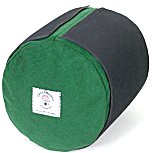
Kneeling roll – The kneeling roll is only needed for the kneeling position. The kneeling roll can be as simple as a towel rolled up or as fancy as a leather cylinder filled with foam material. It is an important part of building a good solid kneeling position. As a right handed shooter I place the kneeling roll under my right ankle while in the kneeling position to help steady me, and to take some of the pressure off of the joint area.
The items above are what I consider the essentials. There are many other accessories that can be purchased later on. In the beginning learning technique is far more important than having all the bells and whistles and the most expensive equipment. Items such as shooting pants, shooting boots, special hats, loading blocks, can be had after you learn the basics.
Courses of Fire
At the Roslyn Rifle and Revolver Club we shoot smallbore rifle competition in a number of different forms. Matches are shot at distances of 50 feet, 50 yards, or 100 yards. Match competition can be as quick as 30 shots (10 shots prone, standing, kneeling) as in our winter league or as long as 160 shots in one of our summer 1600 prone matches. Section 7 of the Smallbore Rifle Rule Book discusses all courses of fire recognized by NRA, while section 17 covers all courses of fire recognized for national records. In our club we hold NRA National Sectionals and New York State regional matches, we also hold matches that are not recognized by the NRA such as an annual turkey shoot and the recently emerging Smallbore Mini Palma.
At the Roslyn Rifle and Revolver Club we own and operate an Indoor facility and an Outdoor facility. We can shoot smallbore rifle indoors or outdoors. Most of our outdoor matches are held in the spring and summer, and most indoor matches are held in the fall and winter months.
Now that you know something about what is needed to begin shooting smallbore rifle please feel free to contact us if you have any questions. At the Roslyn Rifle and Revolver Club we are dedicated to safety and excellence in shooting.